DronG/iStock/GettyImages
Urban dwellers tend to think of pigeons as feathered pests, a cooing, car-splattering nuisance to be avoided. However, pigeons have been domesticated and cherished for thousands of years as a food producer. Their meat is dark and richly flavored, like duck, and they're quick to raise. Squab, or young pigeon, is typically harvested for market at about four weeks of age. It's delicate and tender, and best cooked quickly at high temperatures.
Grilled Squab
Place your squabs on a cutting board. With a sharp, heavy chef's knife, cut each bird in half through the breast bone and backbone. Alternatively, make a cut along either side of the backbone and remove it. Carefully cut out and remove the keel bone that joins the breasts, and flatten out the squab to butterfly or "spatchcock" it.
Marinate the squabs for up to eight hours if you wish, or rest them in your refrigerator in a dry spice rub.
Fire up your grill to medium-high. Remove your squabs from the marinade and pat dry. Brush lightly with oil and season with salt and pepper. If you've used a dry spice rub, spray them with oil instead.
Grill the squabs until the skin is crisp and they're cooked to medium-rare, or 125 degrees Fahrenheit when tested with a thermometer.
Roasted Squab
Preheat the oven to 425 F. Season the squab inside and out with salt and pepper, or other herbs and spices as directed in your recipe.
Cover the breasts of each squab with strips of bacon, or wrap them in thin, lacy pork caul fat if your butcher can get it for you. Squab has little internal fat, and this extra layer of protection will help keep it from drying out.
Roast the squab for approximately 20 to 30 minutes, until their internal temperature reaches 125 F.
Pan-Seared Squab
Cut the squab in half, and marinate them for up to eight hours if you wish. If you're not using a marinade, brush them lightly with oil and season them on both sides with salt and pepper, or other flavorings as directed in your recipe.
Preheat your oven to 425 F. Heat a heavy-bottomed skillet until very hot. Oil it lightly and immediately add the squab, skin side down. Sear the squab halves one or two at a time until they're well browned on each side. Transfer the squab to a baking sheet or heatproof dish and finish them in the oven until medium-rare.
To make a gravy, deglaze the hot skillet with a small amount of red wine, sherry or Madeira. Stir it to loosen the browned-on juices from the squab, then reduce the mixture until it begins to thicken. Whisk in a small piece of cold butter and strain the sauce into a sauce boat or measuring cup. Serve with the squab.
Related Articles
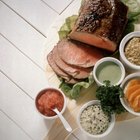
How to Cook 5 Lbs. of Beef Tenderloin

How to Make a Blackbuck Antelope Roast
How to Cook a Lamb Square Cut Shoulder
How to Cook Buffalo Fillet
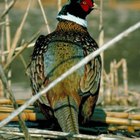
The Best Ways to Cook Pheasant Breast

How to Cook a Petite Filet of Beef in ...

How to Cook Kobe Steaks
How to Cook a Seven Bone Pot Roast in ...
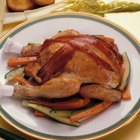
How to Grill a Cornish Hen on the ...
How to Cook Roast Beef in a Cast-Iron ...
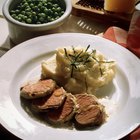
How to Cook Marinated Pork Loin From a ...

How to Cook Texas Broil Roast
How to Cook Boneless Lamb Butterflied ...

How to Cook Beef Sweetbreads

How to Tenderize Gizzards
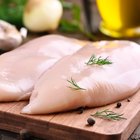
How to Cook Capon Chicken

How to Boil Conch in the Shell

How to Cook Deer Sirloin
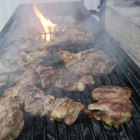
How to Grill Dove Breasts

How to Skin & Cook Squirrel
References
- On Cooking: A Textbook of Culinary Fundamentals; Sarah Labensky, et al.
- On Food and Cooking: The Science and Lore of the Kitchen; Harold McGee
- Larousse Gastronomique, Prosper Montagne (Ed.)
Tips
- Serving poultry at medium-rare is uncommon in the United States, but squab -- like duck -- quickly becomes tough and chewy if it's cooked past that point. Mature pigeons, which tend to become stringy, are usually stewed or braised until fork-tender.
- Caul fat is a sheet of thin, lacy fat that surrounds a hog's stomach. Professional chefs use it to wrap delicate meats because it cooks away almost completely in the oven's heat. Most butchers won't have it on hand, but you can usually order it in advance.
Writer Bio
Fred Decker is a trained chef and prolific freelance writer. In previous careers, he sold insurance and mutual funds, and was a longtime retailer. He was educated at Memorial University of Newfoundland and the Northern Alberta Institute of Technology. His articles have appeared on numerous home and garden sites including GoneOutdoors, TheNest and eHow.